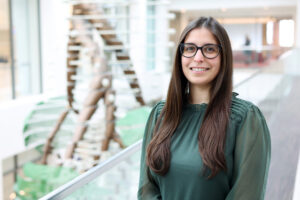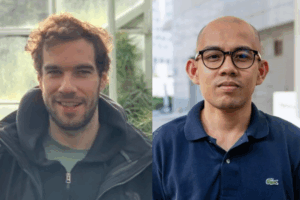Dylan KlURE
Molecular Ecologist Wins Outstanding Graduate Student Award

Dylan Klure. Photo credit: Todd Anderson
At first glance, it might seem a circuitous route to study ecology through the DNA of a desert woodrat. But by using modern molecular biology techniques, Dylan Klure (Dearing Lab), a PhD candidate in the School of Biological Sciences, does just that and in a variety of compelling, integrated and collaborative ways.
To answer the question, “how does an organism interact with its environment?” an ecologist might traditionally study that organism’s behavior or its competition with other species and study its population trends over time. But Klure, who was awarded this year’s Outstanding Graduate Student from the College of Science at the University of Utah and considers himself a molecular ecologist, wants to know how that organism has changed over time and what adaptations that organism has at the level of its genome that allow it to live successfully in its current habitat.
In the case of the desert woodrat, populations in the southwestern United States have experienced gradual changes in climate over the last ~15,000 years since the end of the last ice age. This environmental change has led to the expansion of a highly toxic plant, creosote bush, across much of this region and now many woodrat populations must rely on this toxic plant as a food resource. “Some woodrat populations have really experienced a lot of change in that time, and other ones haven't. So we can compare those two populations of woodrats and ask what's different or not different in their genomes in response to that environmental change.”
Certain populations of the desert woodrat, largely in the Mojave Desert, are able to consume large quantities of creosote bush, without becoming ill. Klure and his colleagues have found that these woodrats have evolved novel genes that code for enzymes in their liver that can degrade the toxins in creosote bush. Additionally, these woodrats have acquired beneficial microbes in their gut that also help degrade these toxins. These dramatic findings show how historic climate change has shaped the evolution of woodrats.
The implications of such discoveries are two-fold: first, by documenting how animals have responded to past climate change events, scientists can better predict how animals may respond to our current age of rapid climate change. Second, researchers are figuring out the link between what enzymes produced in the liver successfully degrades (or neutralizes) which types of toxins, something that is not well understood in humans.
“It’s complicated,” says Klure. “A single human can produce several dozens of unique enzymes in the liver in response to medicinal use or drug use. And knowing which of those enzymes are actually acting on which toxin or if they're acting sequentially” is a critical benchmark that might inform the development of future medicines.
A team effort that is both ongoing and built on the work of previous graduate students and post-docs, this research has led to multiple publications for the fifth-year graduate student. Articles in peer-reviewed journals have addressed not only how gut microbes in these woodrats allow them to feed on toxic plants, but more broadly, how microbes in the gut get there in the first place, what impacts the microbe community and what factors might predict what species of bacteria one finds in what animals.

Bryant's woodrat (Neotoma bryanti) feeding on the toxic creosote bush
Ecologists take into account how an organism interacts with its entire environment, but that can be complicated to measure. While the subject model for Klure might be woodrats, a “goldmine of knowledge” comes from their feces. “First of all, there is host DNA in feces”, says Klure. “Woodrats are shedding their own intestinal cells, so their DNA is in there. And whatever they're eating [that] DNA is in there. The bacteria in their gut’s DNA is in there. It's all in there.” From a single fecal pellet, scientists can determine who that animal is, what they are eating and what types of microorganisms they harbor in their gut.
It is these modern molecular approaches used to ask evolutionary and ecological questions that excites Klure the most. “I can start understanding how the organism is interacting with its environment, from a much more holistic view. Essentially, [I] don't have to just rely on what I can see with my own eyes.”
Klure and team employ techniques that range from DNA sequencing to gene expression assays and from pharmacological assays to test the activity of enzymes to “western blotting,” a technique used to characterize what proteins are in a sample using fluorescent antibodies.
Klure is slated to defend his dissertation in May and upon graduation will immediately begin work as a post-doctoral researcher in the Dearing Lab to finish up some of his research there. This will be followed most-likely by another stint as a post-doc elsewhere. He is planning to pursue a career in academia, where he would like to continue performing research alongside undergraduate students as this has been one the most rewarding parts of his graduate experience. He enjoys crafting research projects with undergraduate students that are feasible in scale so that they can contribute to the entire research process. Referencing his own experience as an undergraduate at the University of Redlands, he says, “it's cool to see that the students actually get to help design their own project and actually run it all the way to completion before they graduate.”

Teaching kids at the Natural History Museum of Utah about the ecology of woodrats (photo credit - C. Hernandez)
With his partner, you can find Klure, a California native, with his spin rod, fishing in Utah’s outback, a welcome relief from the bench and fieldwork of all things woodrats. Outside the lab, the molecular ecologist has also found a home in advocating for the LGBTQ+ community that finds itself in STEM-related fields at the U. He co-founded the LGBTQ+STEM Interest group, alongside fellow graduate student Andy Sposato and biology professor Ofer Rog, and this work has proven gratifying the past few years. The goal of this organization is to foster professional development and community advancement for LGBTQ+ individuals pursuing careers in STEM.
“There really aren’t any LGBT resources for the most part at the grad-student-and-above level,” he says, remarking that most universities have some type of program and support system for undergraduates, but not for graduates, post-doctoral researchers and faculty. “That is where LGBTQ+ people are the most underrepresented.”
That Dylan Klure is recipient of the Outstanding Graduate Student award will only help elevate graduate students, like himself, and faculty who identify as LGBTQ+.
By David Pace




